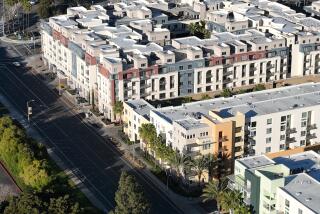Building From a Giant’s Blueprint
- Share via
The nation’s biggest home builder isn’t exactly a household name.
But D.R. Horton Inc. got there by emulating one: Wal-Mart.
By adapting the discount retailer’s concept of low overhead to housing, Arlington, Texas-based D.R. Horton has taken on small and medium-sized builders that can’t match its economies of scale. What’s more, the company has stayed more nimble than its rivals because its operations are decentralized.
And it has more than mimicked Wal-Mart Stores Inc. in its relentless growth. Two years ago, D.R. Horton surpassed Wal-Mart’s record of 99 consecutive quarters of earnings growth (it’s now up to 108 and counting.) Two months ago, it completed its 27th fiscal year of consistently higher profit. Over the last decade, its stock has risen at a compounded annual growth rate of 33%, making the company the biggest builder in terms of market value, which stands at $8.5 billion.
D.R. Horton built fewer than 900 homes in 1992, the year it went public. In its just-completed fiscal year, the company sold more than 45,000 homes -- an industry record.
In large measure, D.R. Horton grew very big very fast because of its aggressive push into California, where it focuses on entry-level and “first-time move-up” homes priced at less than $600,000. About 40% of D.R. Horton’s $975.1 million in annual profit comes from the Golden State.
Thanks to some key acquisitions, D.R. Horton is the biggest player in California, passing such industry titans as KB Home, Centex Corp., Standard Pacific Homes and Pulte Homes Inc.
“Instead of setting up its own operations, D.R. Horton bought local operators and bought the local knowledge,” said industry consultant Russ Valone. “That has been a key aspect of Horton’s success.”
Another reason: D.R. Horton lets local managers make decisions about what kinds of products work in their markets, said Thomas Noon, D.R. Horton’s California president.
“Horton decided a long time ago that it wanted to control the results, but not control the method,” said Noon, a former Shea Homes executive who was D.R. Horton’s first employee in the state in 1992. Headquarters sets goals for regional presidents and division managers, leaving it to them to figure out how to hit the targets. “If they can’t, then we have the wrong person,” Noon said, “not the wrong process.”
As a result, the company is faster on its feet than most competitors. When prices zoomed beyond the reach of its core customers, D.R. Horton downshifted by building smaller units on smaller lots. In fiscal 2004, the company’s average sales price in California rose 2% to $416,000, while the statewide median for homes by all builders climbed 13%.
In Orange County, D.R. Horton’s $473,000 average price and 1,685-square-foot average size are the lowest and smallest of the top six builders in the county, according to data compiled by the company and research firm Hanley Wood Market Intelligence, formerly Meyers Group.
In places such as San Diego and in Orange County, D.R. Horton has moved quickly into condos and townhouses, niches that have lower price points and that other big builders have been slow to tap.
“We didn’t even consider doing that three years ago,” said Noon, who runs the company’s California operation and oversees its 1,100 employees from his Carlsbad office.
But D.R. Horton isn’t giving up on single-family homes: It is extending its reach into so-called satellite markets. From the company’s Valencia division, D.R. Horton jumped into Bakersfield in Kern County, where land is cheaper and the market is dominated by small private builders who can’t compete with D.R. Horton on costs.
“What they call their Wal-Mart strategy is to move into new cities where their competitors are not,” said Greg Gieber, an industry analyst at A.G. Edwards & Sons.
The other part of its Wal-Mart strategy involves -- what else? -- using its size to drive a hard bargain on costs. Like Wal-Mart, D.R. Horton uses its heft to negotiate lower prices for supplies such as roofing materials, door frames and appliances.
In fiscal 2004, D.R. Horton saved $145 million as a result of its national and regional purchasing programs. That worked out to savings of about $3,300 per house, versus $2,800 in 2003, improving gross profit margin on home sales to 22.8% from 20.6%.
D.R. Horton is “very focused on being very efficient operationally,” said Irvine industry consultant John Burns. “There is not a lot of waste in a D.R. Horton home.”
Some have questioned how much quality is in their homes as well. Indeed, buyer satisfaction is a touchy issue for the company.
For four years running, D.R. Horton has received average to below-average scores in customer satisfaction surveys conducted by J.D. Power & Associates that assess the quality of workmanship, home design and relative price and value.
“Home building is a highly competitive industry, and those that sell a lot of homes have a certain amount of competence to compete,” said Paula Sonkin, a senior real estate industries director at J.D. Power. “Among the builders that do well, Horton does not have the strength in the areas that customers find important.”
The criticism rankles D.R. Horton executives, who question how the company can be the fastest-growing builder if so many customers are dissatisfied.
“We give no weight to J.D. Power’s ratings,” Noon said. In California, he said, D.R. Horton conducts its own customer satisfaction surveys for which division managers are held accountable if scores fall behind.
Founded in 1978 by real estate agent Don Horton, the company started out selling new homes in the Dallas-Fort Worth area and then switched to building them. D.R. Horton went public in 1992 and, armed with an escalating stock price, acquired 17 companies over the next decade. Outside of California, D.R. Horton erects homes in 51 markets in 21 states. Horton remains chairman of the company.
D.R. Horton entered California in 1992 in Los Angeles and San Diego counties. In 1998, it vaulted to the top tier of national builders with the $400-million purchase of Continental Homes, which was well positioned in the state. D.R. Horton solidified its spot in the big leagues in 2002 when it acquired Schuler Homes, a Hawaii-based builder that had projects in Orange County, the Inland Empire and other key markets.
The acquired companies operate as branded divisions, which are better known in California than D.R. Horton. Soon, all new housing projects will carry the D.R. Horton name, Noon said.
The change coincides with the company taking the reins as California’s largest builder. It builds roughly 8 out of every 100 homes in the state, which is not so puny a market share as it may seem. California is the nation’s second-largest housing market, behind Florida, in terms of new construction, with more than 480 companies -- most of them privately held -- taking nail guns to wallboards every year.
In California’s overheated housing market, D.R. Horton’s lower-priced homes have hit what Chief Executive Donald Tomnitz likes to call “the sweet spot”: first-time and first-time move-up buyers.
“I can tell you when you get down to 20% of the people in the state of California being able to afford your homes, you better be repositioning your product and doing something so you can get closer to 30%, which is what we’ve done,” Tomnitz told investors last month.
D.R. Horton does build homes that are priced in excess of $1 million, but its real skill lies in selling to first-time buyers and first-time move-up buyers, analyst Gieber said.
“It would be like Wal-Mart selling fur coats -- it’s not their area of expertise,” he said.
D.R. Horton’s long run looks to continue at least another year or two, industry analysts believe. Although D.R. Horton is coming off its best year ever, profit in 2005 and 2006 looks to rise 12% and 10%, respectively, according to a consensus of analysts surveyed by Thomson First Call.
Although D.R. Horton has said it will slow its pace of acquisitions this year, choosing instead to focus on expanding in markets it has entered, the company plans to increase home sales to 63,000 in 2006 -- and to the once-unthinkable level of 100,000 a year thereafter.
In California, D.R. Horton’s goals are equally lofty. Noon plans on selling 1 in 10 new homes in California by 2007.
The tallest hurdle standing in the company’s way is mortgage rates, which have been at historically low levels and appear poised to rise in the coming year. A sizable uptick in rates would curb demand from D.R. Horton’s most important customer.
“We’ve been preparing for market softness for three years now,” Noon said.
“Everyone may want a million-dollar home,” he added, “ But by selling homes at a lower price point, that’s what people need as opposed to what they may want.”
More to Read
Inside the business of entertainment
The Wide Shot brings you news, analysis and insights on everything from streaming wars to production — and what it all means for the future.
You may occasionally receive promotional content from the Los Angeles Times.










